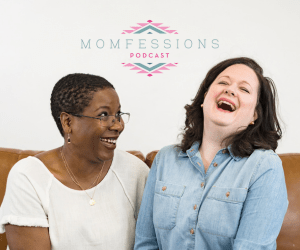
My son was born at 38 weeks. He was seven pounds and 13 ounces of cheeky deliciousness. I thought, “I made this beautiful baby and now he’s out of the womb, and they’re just going to let me walk out of here with him?”
As soon as the shock of birth wore off, we became obsessed, and jumped headfirst into parenting. But there was one problem. My perfect angel would not breastfeed.
>> RECOMMENDED RESOURCE :: Breastfeeding Resources in and Around Dallas <<
Coping with a Non-Breast Feeder
Oh, the things we tried: The sandwich method, nipple shields, different positions, more pillows, less pillows, encouraging a letdown first so baby wouldn’t have to work as hard. . . . You get the point. We did it all.
My husband and I spent two months stressed beyond words because his bilirubin levels wouldn’t go down, and his weight wouldn’t go up. By the time we realized he wasn’t effectively removing milk, my supply (which was plentiful at first) had tanked. No amount of water, oatmeal, fenugreek, blessed thistle, Reglan, or power pumping would bring it back.
After many tears and reaching a point of utter exhaustion, my husband said the words I needed to hear, “A happy mommy is more important than breastmilk, and maybe you need to let go.”
And I did, y’all. Up until that point, I really had been so stressed and filled with guilt that I hadn’t enjoyed him. It felt like a weight had been lifted, and it was such a turning point for me.
>> RELATED READ :: My Story of Surviving Breastfeeding & Bottle Feeding Judgment from My Family <<
So What Caused Our Breastfeeding Troubles?
Well, I had small nipples. Small breasts that just don’t “sandwich” well. He had a high palate. He was lazy. Etc., etc., etc. I just prepared myself to formula feed all my kids. I’m not anti-formula in the least, y’all. Heck, my son would have starved without it! What I am is is cheap and lazy.
But then my daughter was born. Even though she was in the NICU where I couldn’t nurse or pick her up for the first six days, she latched perfectly the first time and we never looked back.
Thanks to pumping, my supply was plentiful and when we left the hospital, I was making enough for triplets and had to correct an oversupply! We are still nursing at 15 months. Same boobs, totally different story. So what was different? The baby. And more specifically, the baby’s mouth.
 Tongue Tied
Tongue Tied
I finally had an epiphany this spring. My now three-and-a-half year old has a few sounds he still can’t say correctly. There was one category in particular he couldn’t produce at all — the velar sounds, which are formed when the back of the tongue lifts to meet the roof of the mouth (think “k”, “g”, and “ng”).
I had my sister, who is a speech language pathologist, do a mini-eval, and she agreed he had limited mobility of the back of his tongue. We went to see a dentist who has had special training in identifying and treating tongue and lip ties. Turns out, my son had a very severe posterior tongue tie. The tip of his tongue is fine. It moves and can stick out, but the back of his tongue is stuck down. His tongue is bowl-shaped because the back of his tongue is completely attached to the floor of his mouth.
Advocate for You and Baby
All this to say, multiple professionals saw my son during our breastfeeding woes, and a few even checked his mouth, but no one caught his less obvious posterior tongue tie. My son’s own dentist advised against treating it when I brought it up most recently. I strongly advise, in all things, to advocate for your child and listen to your mommy gut.
Even though I no longer felt guilty about not nursing him, the whole thing never sat well with me. I knew there had to be more to it. And, lo and behold, a quick in-office procedure could have saved our breastfeeding relationship, and set a completely different tone for my first weeks of motherhood.
Tongue ties are not a new thing. It is said that midwives used to keep a sharp knife (or fingernail!) to sever the frenum after birth, if it was necessary. Since then, formula was invented and more and more babies were bottle fed. A tongue tie does not interfere nearly as much with a bottle nipple than with a human nipple, so the existence of a tongue tie became less problematic. As our culture moves back towards breastfeeding, we are seeing an increase in tongue ties being diagnosed.
>> RELATED READ :: 8 Things I’d Tell a First-Time Mom About Breastfeeding <<
Untying the Tongue Tie
My son’s tie was revised with a laser last month, and although the healing process wasn’t too bad, I would recommend getting it done as young as possible. A week after the procedure, I could see the back of his tongue raised normally!
However, revisions aren’t always necessary because posterior ties may not be severe enough to cause problems. For example, a child may have a tongue tie but can speak and eat normally. My husband, the genetic culprit, never knew he had one because his tie doesn’t cause him problems. If a tie doesn’t cause problems and there are no symptoms to treat, then treatment isn’t recommended.
Resources for Diagnosing, Treating, and Correcting a Tongue Tie
Because you may not know that your children (or you!) are tied, check out the list of symptoms and links to resources below. Warning, just looking in the mouth may not be enough! And please share this information with your friends. I don’t want anyone else to go through the stress we went through simply because they hadn’t heard of this possibility.
- Dr. Kotlow’s website is an amazing collection of articles, pictures, and videos about tongue tie and upper lip tie.
- This newsletter from The American Academy of Pediatrics documents the impact of tongue tie on breastfeeding.
- Join this Facebook group: Texas Tongue Tie Babies and Children Support Group.
- Here is a list of symptoms, general information, and helpful pictures and illustrations.
- Search this list for preferred providers of tongue tie and lip tie revisions and support.














I’m surprised lactation consultants aren’t better trained to identify tongue and lip ties. I spent the first 48 hours of my daughter’s life in agony trying to breastfeed her. All the lactation consult did was say I needed to help her latch better. It took our pediatrician two minutes with my daughter to diagnose her tongue tie.
SO glad your pediatrician caught it! I think one difference between is “lactation consultant” and IBCLC- some LC’s are RN’s with a little something extra, whereas IBCLCs have far more training! Had we seen the latter, we might have caught it sooner!
Good point about the IBCLC training being different, Dana. When we hired our IBCLC staff member we were amazed at the specificity of her training. If only all mothers had access to such lactation consulting!
Glad to read that your son is thriving after the procedure.